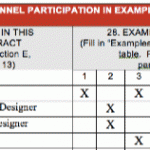I didn’t post anything the last couple weeks. I’ve been working hard on a SMPS Foundation white-paper. That is in for review, which frees my train ride up. Let the posts begin!!
And boy do I have a few doozies for you in the next couple weeks. The first of which I’ve decided to make exclusive to this site. It’s an interview I did with Jan Tuchman, the Editor in Chief of Engineering News Record. This is a great suppliment to my piece on how to get into ENR.
When I was flying back to Philadelphia from Build Business 2010, I sat next to a marketer who told me about her Principal’s marching orders to get their latest and greatest project “written about in ENR.” To me, this anecdote highlighted the importance of my Build Business Interview with Jan Tuchman, Editor-in-Chief of Engineering News Record (ENR). In it, she not only explains how to pitch a story to ENR, but she gives valuable insight into the inner workings of the magazine and how they view the news.
Matt: At ENR, how do you determine what is newsworthy?
Jan: It has a lot to do with developing your news instincts over the years. Something that’s very important to me is that we’re gathering news every day and we’re trying to be neutral as to the medium with which we reach our readers. We’re gathering the data, analysis, and commentary that we feel our readers need to do their jobs more effectively. So that’s our mission and we’re always asking, “will this piece of information help our readers in some way do their job more effectively?”
In the modern era with all the electronic communication you get feedback right away. When we send out a news alert we know who opened it, how many people opened it, and how many people clicked through to that story. So part of our present-day sensibilities have to do with knowing that the readers are interested in this topic because they’re clicking on it. So, that’s informing us in a different way then we were informed in past. Part of the past thing was just one-on-one communications. We know what people are interested in because they tell us. We do little surveys and we have staff members who have been around quite a while now.
We have younger staff, as well. We are always in the training mode and always developing that feedback mechanism that helps us determine what is helpful to the readers. One of them did a survey about a year ago that identified the number one thing our readers said they were interested in was, “news about my region,” which is very interesting. It makes sense, but it wasn’t something we asked before. We were asking because we have a group of regional magazines and with this information we are strengthening the ties between regional magazines and the national brand.
The other thing we’ve learned is they’re very interested in construction methods, engineering technology, legislation, regulation, and safety topics that go across the industry as a whole. That’s the thing about ENR; we are a magazine for the entire construction industry so that means every kind of project, all different markets and also all different professions. All kinds of people of people read ENR, so we’re one of the things that brings the industry together.
M: Just about everybody reads ENR. In addition, my sense is everybody and their mother wants to be in ENR, so how to do balance this unique situation where your clients are also your sources?
J: The stories that meet our expectations mostly get written. First of all it has to be new. We are looking for projects that are innovative and challenging. When people come and say, “This is the tallest building in Albuquerque,” we go, “So? And why is that important?” We are looking at the nation. Sometimes we write about the first time an innovative construction technique is used in the United States because it is hard to get new methods adopted in this country. We have been traditionally slow to adopt. But because this method was used in Chicago doesn’t matter because we already wrote about it when it was used in Denver.
M: One of the things I used to do, but don’t do anymore, is subscribe to the press release news wires. And I would see these press releases come through, but I don’t think I’ve ever seen a shred of news in any of them. I wonder, is the press release dead?
J: What I really hate is getting emails saying press release. Why am I going to open that in email? For example, I got an e-mail from Tom Dickman from AECOM last night saying we just acquired Tishman Construction. Oh wow. And that was something in the headline of the email. But I was going to say that someone sent me an e-mail that said something like, story pitch. Now story pitch to me is like in a whole different category than press release. I opened it up and thought, “Ok, what’s the story you are pitching?” Its just a different name really, that’s what a press release is. But its as if press release makes it sound like, “oh, you’re just going to take this information and run it,” and story pitch makes it sound like, “we have an idea for you and we think that’s what happened to us is worth your attention so you should interview us” So, it’s a different kind of twist which I think is much more provocative.
M: I remember working at a local newspaper in college and our little newspaper was just inundated with press releases. I can’t imagine how many ENR gets. Is the better approach to try and put on Jan’s shoes and ask, “Is this really news worthy? Is this something the ENR readership would be interested in?”
J: Well, the bread and butter of ENR is people who are willing to share their ideas. They are sharing their ideas because it’s good for the industry and in a sense they are sort of giving back. They are also sharing ideas because they want to get publicity and they think sharing ideas will help them get other jobs. But there are people who don’t want to talk to us because, “oh we have a great idea and we are going to keep it secret because we don’t want to give anybody else our ideas.” That does happen. They don’t want to give away competitive advantage.
M: Can you tell us about some of the big stories you worked on at ENR?
J: Last year’s big story was the stimulus package. We felt that the readers needed every scrap of information they could get about it because they needed to figure it out. It was very complex and they need to figure out how to get some of that work because they were so desperate for work. Perhaps the year before that, the big story was the Minneapolis bridge collapse. The story was not just what went wrong there, but that the whole country needed to know about the state of the ailing infrastructure in the U.S.
M: When you are publishing ENR, are there stories that don’t make the cut?
J: Oh yea, but not as much anymore. If they don’t make the print edition they may end up in the electronic publication. There are more limitations with print. There are certain spaces that are allocated. Some things that don’t go in print may go online, where space is not the issue but time and resources is still an issue.
Because anyone in the world can read our website, we are looking for good ideas for stories around the world. What we’ve realized is that we have all this space on the internet, but we have a limited amount of editor’s time. These stories still have to be edited, they have to be commissioned, and we have to pay our freelances, so there are limitations on our work even in an all-electronic environment.





[…] An Exclusive Interview with Editor-in-Chief Jan Tuchman […]